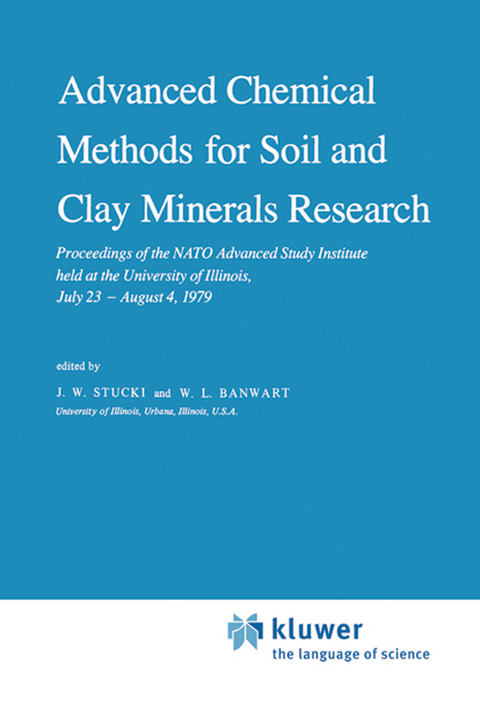
Advanced Chemical Methods for Soil and Clay Minerals Research
Springer (Verlag)
9789400990968 (ISBN)
1. Mössbauer Spectroscopy.- 1-1. Introduction to the Mössbauer Effect.- 1-2. Basic Principles of Mössbauer Spectroscopy.- 1-3. Instrumentation and Experimental Procedures.- 1-4. Application of Mössbauer Spectroscopy to the Study of Silicate Minerals.- 1-5. The Study of Mineral Alteration Reactions.- 1-6. Iron Oxides and their Characterization in Soils.- 1-7. Critical Assessment of the Potential of Mössbauer Spectroscopy, and its Application to Nuclei Other than Iron.- References.- 2. Neutron Scattering Methods of Investigating Clay Systems.- 2-1. Introduction.- 2-2. Elementary Neutron Scattering Theory.- 2-3. Neutron Scattering Instrumentation and Methods.- 2-4. Applications of Neutron Spectroscopy to Studies of Clay Minerals.- Appendix 2-1. Macroscopic Cross Section for a Montmorillonite-Water System.- Appendix 2-2. Calculation of Incoherent Scattering Intensity Ratios for a Clay-Water System.- References.- 3. Introduction to X-ray Photoelectron Spectroscopy.- 3-1. Introduction.- 3-2. Trend of XPS Spectra.- 3-3. Instrumentation.- 3-4. Peak Position.- 3-5. Explored Depth.- 3-6. Peak Intensity.- 3-7. Overview of Methods of Characterization of Solids Based on X-ray, Electron and Ion Beams.- References.- 4. Application of X-ray Photoelectron Spectroscopy to the Study of Mineral Surface Chemistry.- 4-1. Uniqueness of XPS for the Investigation of Mineral Surface Phenomena — Probing Depth.- 4-2. Sample Handling Techniques.- 4-3. Analytical Applications.- 4-4. Electron Take-Off (Grazing) Angle Analysis Applications.- 4-5. Qualitative Bonding Investigations.- 4-6. Summary.- References.- 5. The Application of NMR to the Study of Clay Minerals.- 5-1. Introduction: Fundamentals of NMR.- 5-2. The Bloch Equations.- 5-3. Line Shape.- 5-4. Relaxation Mechanisms.- 5-5. Review ofSome Problems: Order and Disorder in Adsorbed Water Molecules.- References.- 6. Distribution of Ions in the Octahedral Sheet of Micas.- 6-1. Introduction.- 6-2. Influence of the Fe2+ Ions.- 6-3. H+ Spectra of Phlogopites.- 6-4. H+ Spectra of Biotites.- 6-5. F? Spectra.- 6-6. Correlation with I.R. Results.- References.- 7. General Theory and Experimental Aspects of Electron Spin Resonance.- 7-1. Introduction.- 7-2. G-Factor Tensor.- 7-3. Hyperfine Interaction.- 7-4. Analysis of ESR Spectra.- 7-5. Fine Structure.- 7-6. Summary.- Appendix 7-1.- Appendix 7-2.- Appendix 7-3.- References.- 8. Applications of ESR Spectroscopy to Inorganic-Clay Systems.- 8-1. Introduction.- 8-2. Surface-Bound Metal Ions.- 8- 3. Framework Paramagnetic Centers.- References.- 9. Application of Spin Probes to ESR Studies of Organic-Clay Systems.- 9- 1. Nitroxide Spin Probes — Origin of the ESR Spectrum.- 9-2. Nitroxides in Low-Viscosity Media — Rapid Isotropic Motion.- 9-3. Nitroxides in High-Viscosity Media.- 9-4. Nitroxides Adsorbed on Clay Surfaces.- 9-5. Experimental Considerations in Using Nitroxide Spin Probes.- References.- 10. Applications of Photoacoustic Spectroscopy to the Study of Soils and Clay Minerals.- 10-1. Introduction.- 10-2. Instrumentation.- 10-3. Results.- 10-4. Conclusions.- References.
| Reihe/Serie | NATO Science Series C ; 63 |
|---|---|
| Zusatzinfo | X, 477 p. |
| Verlagsort | Dordrecht |
| Sprache | englisch |
| Maße | 155 x 235 mm |
| Themenwelt | Naturwissenschaften ► Biologie ► Ökologie / Naturschutz |
| Naturwissenschaften ► Geowissenschaften ► Geologie | |
| Naturwissenschaften ► Geowissenschaften ► Mineralogie / Paläontologie | |
| Technik ► Umwelttechnik / Biotechnologie | |
| Weitere Fachgebiete ► Land- / Forstwirtschaft / Fischerei | |
| ISBN-13 | 9789400990968 / 9789400990968 |
| Zustand | Neuware |
| Informationen gemäß Produktsicherheitsverordnung (GPSR) | |
| Haben Sie eine Frage zum Produkt? |
aus dem Bereich


